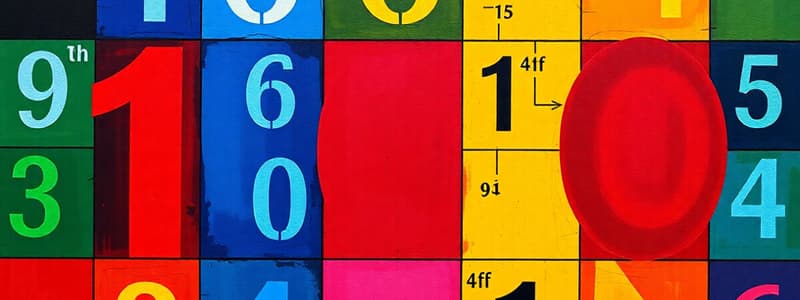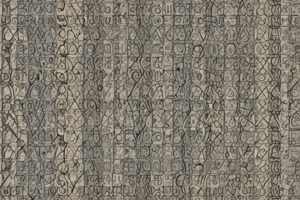Podcast
Questions and Answers
The common difference in the sequence 4, 7, 10, 13, … is ___.
The common difference in the sequence 4, 7, 10, 13, … is ___.
3
In the sequence -2, -6, -10, -14, …, the common difference is ___.
In the sequence -2, -6, -10, -14, …, the common difference is ___.
-4
A sequence that forms by adding a fixed number to the preceding term is called an ______ sequence.
A sequence that forms by adding a fixed number to the preceding term is called an ______ sequence.
arithmetic
For the sequence -4, 3, 10, 17, the common difference is calculated as ______.
For the sequence -4, 3, 10, 17, the common difference is calculated as ______.
If the first term is 5 and the common difference is -2, the second term will be ______.
If the first term is 5 and the common difference is -2, the second term will be ______.
In the 25-layer log pile, if the uppermost layer has 25 logs and subsequent layers contain two more logs than the first layer, you can find the total number of logs.
In the 25-layer log pile, if the uppermost layer has 25 logs and subsequent layers contain two more logs than the first layer, you can find the total number of logs.
In the arithmetic sequence where the first term is 23 and the common difference is d, if the sum of the first 15 terms is 765, we need to find the common difference to solve for d.
In the arithmetic sequence where the first term is 23 and the common difference is d, if the sum of the first 15 terms is 765, we need to find the common difference to solve for d.
If 𝑆𝑛 = 50, 𝑎1 = 4, and 𝑎𝑛 = 16, we are tasked to find the value of N
If 𝑆𝑛 = 50, 𝑎1 = 4, and 𝑎𝑛 = 16, we are tasked to find the value of N
The sum of the first 23 integers that are divisible by 3 is calculated to be ____.
The sum of the first 23 integers that are divisible by 3 is calculated to be ____.
Flashcards are hidden until you start studying
Study Notes
Arithmetic Sequences
- An arithmetic sequence consists of terms where each term after the first is formed by adding a fixed number, known as the common difference (d), to the preceding term.
- Common difference is calculated by subtracting any term from its previous term: ( d = a_n - a_{n-1} ).
Examples of Sequences
- 2, 4, 6, 8, ...: Common difference is 2 (obtained by adding 2 to the previous term).
- 3, 6, 12, 24, ...: Common difference is achieved through multiplication (not an arithmetic sequence).
- 5, 10, 15, 20, ...: Common difference is 5.
Finding Terms in Arithmetic Sequences
- To find the next two terms, continue adding the common difference to the last known term.
- For the sequence 4, 7, 10, 13, ...: the next terms are 16 and 19 (common difference is 3).
Solving Arithmetic Sequence Problems
- Verify if a sequence is arithmetic by checking if the differences between consecutive terms are equal.
- Example: In the sequence -4, 3, 10, 17, the common difference is 7 (next terms are 24, 31, 38).
Practical Applications
- Arithmetic sequences can be observed in real-life situations, such as fare rates that increment consistently per kilometer (e.g., in public transport fare structures).
Terminology
- Arithmetic Sequence: A sequence in which each term after the first is formed by adding a common difference to the preceding term.
- Common Difference (d): Fixed amount added between consecutive terms.
Assessment Practice
- Problems may ask for definitions, identification of sequences, and calculation of terms or common differences in various sequences.
- Example Problems:
- Identify if a sequence is arithmetic.
- Calculate the common difference or find missing terms based on given values.
Example Situations
- Walking routine can illustrate an arithmetic sequence, by increasing daily distance.
- Daily work output doubling every two hours is geometric, not arithmetic.
Key Concepts
- Identify patterns in sequences to determine next terms and common differences.
- Use equations and sequences analytically to solve problems in various contexts.
Module Overview
- Focus on finding the ( n )th term and arithmetic means of an arithmetic sequence in Mathematics 10.
- Mastery of these skills is essential for progressing in subsequent lessons.
- Designed to provide interactive tasks for developing desired learning competencies.
Structure of the Module
- What I Need to Know: Skills and competencies expected from the module, includes an initial activity for pre-assessment.
- What I Know: Brief review linking current lessons to previous knowledge, includes a drill or review activity.
- What’s New: Introduction of the new lesson through various engaging methods (e.g., stories, songs, problems).
- What Is It: Discussion of new concepts and skills, includes independent practice activities.
- What’s More: Additional exercises for solidifying understanding.
- What I Have Learned: Reflective activity to process learning outcomes.
- What I Can Do: Tasks applying new knowledge to real-life situations.
- Assessment: Evaluation of mastery of learning competencies through specific tasks.
- Additional Activities: Enrichment tasks for skill retention.
- Answer Key: Solutions provided at the end for self-assessment.
- References: List of sources used in module development.
Key Concepts in Arithmetic Sequences
- Arithmetic sequence characterized by a first term ( a_1 ) and a common difference ( d ).
- General formula for the ( n )th term: [ a_n = a_1 + d(n - 1) ]
Application of Concepts
-
Example 1: Finding the 21st term of the sequence 6, 9, 12, 15:
- ( a_1 = 6, d = 3, n = 21 )
- Calculation: ( a_{21} = 6 + 3(21 - 1) = 66 )
-
Example 2: Finding ( n ) if ( a_n = 304 ) in the sequence 7, 10, 13, 16:
- ( a_1 = 7, d = 3, a_n = 304 )
- Calculation leads to ( n = 100 ).
-
Example 3: Given the 3rd term 8 and the 16th term 47, find ( d, a_1 ), and the 71st term:
- Set equations from terms and solve for ( a_1 ) and ( d ), leading to ( d = 3 ).
- Find arithmetic means and terms, resulting in 10, 12, and 14 between 8 and 16.
Inserting Arithmetic Means
- To find 2 arithmetic means between ( \sqrt{2} ) and ( 4\sqrt{2} ):
- Calculate common difference ( d ) and insert calculated means ( 2\sqrt{2} ) and ( 3\sqrt{2} ).
Finding Missing Terms
- Given an arithmetic sequence with some terms missing, determine common difference ( d ) and find missing values.
Real Life Applications
- Example problems involve calculating salary raises or distances based on arithmetic sequences.
Reflection and Practice
- Ends with practice exercises and reflection questions in various formats to reinforce learning and retention of arithmetic sequences.
Arithmetic Sequences
- An arithmetic sequence is a sequence of numbers in which the difference between consecutive terms is constant, known as the common difference (d).
- The sum of the first n terms (Sₙ) can be calculated using two formulas depending on whether the last term is given.
Sum Formulas
-
If the first term (a₁) and the last term (aₙ) are known:
- ( Sₙ = \frac{n}{2} (a₁ + aₙ) )
-
If the last term is not provided:
- ( Sₙ = \frac{n}{2} [2a₁ + (n - 1)d] )
Example Problems
- Sum of First 13 Terms: For the sequence -3, -1, 1, 3, the calculation requires identifying the first term, common difference, and using the appropriate sum formula.
- Sum of First 15 Terms: In the arithmetic sequence 10, 15, 20, 25, apply the sum formula with n = 15, a₁ = 10, and d = 5.
- Sum of All Even Integers from 10 to 70: This involves identifying the range, counting terms, determining the first and last terms and utilizing the sum formula for even integers.
- Sum of All Odd Integers from 1 to 50: Calculate the series of odd integers, recognizing the sequence starts at 1 and ends at 49.
Special Cases
- The sum of integers from 8 to 35 is computed by using the sum formula for a defined range.
- Total number of logs in a stacked sequence with an increasing pattern requires recognizing the arithmetic sequence established by the logs' layers.
Assessments and Exercises
- Determine Values: Problems may ask to find the first term or the common difference when given the sum of the first n terms and specific terms.
- Analytical Skills: Each problem emphasizes understanding arithmetic series and applying formulas to deduce sums or find unknown variables within sequences.
Conclusion
- Mastery of finding sums in arithmetic sequences provides a solid foundation for solving numerical problems effectively.
- Key concepts include recognizing sequences, applying formulas correctly, and verifying the results through logical calculation.
Studying That Suits You
Use AI to generate personalized quizzes and flashcards to suit your learning preferences.



